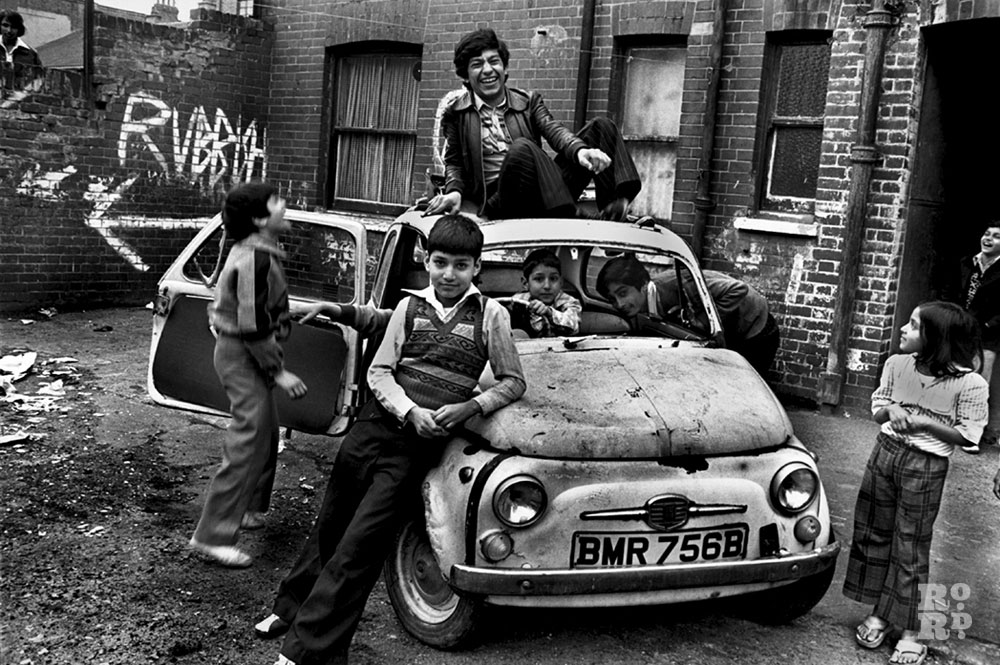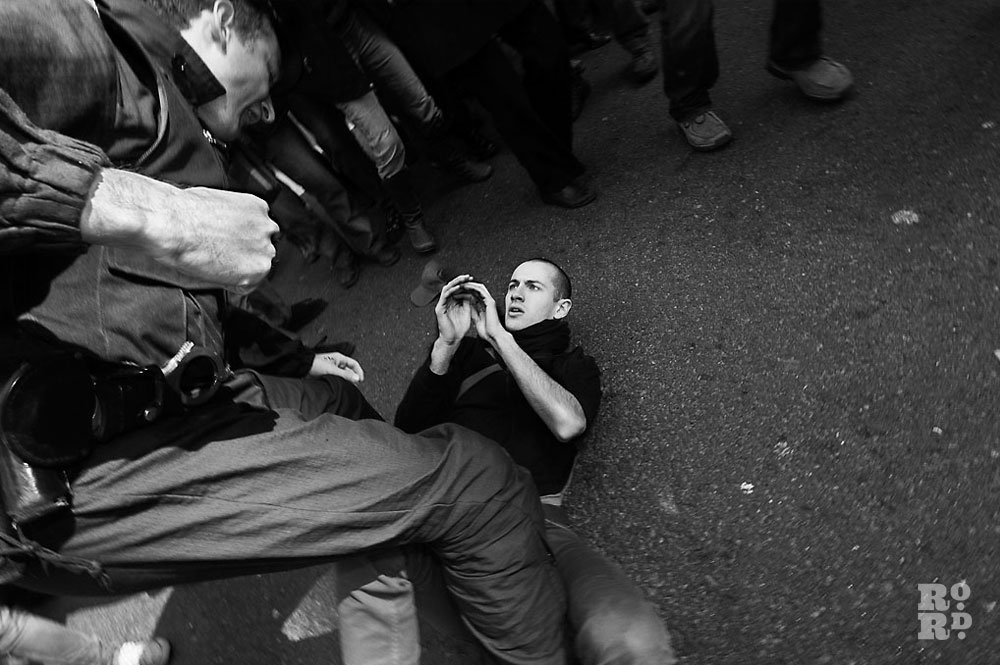David Hoffman: chaos, riots, slums and the East End
Photojournalist David Hoffman has spent more than 40 years photographing the happenings on the streets of London, with a particular focus on his East End hometown, and with his lens predominantly focused on those less fortunate than most.
His subjects have included the homeless, the addicted, and the enraged, and spanned slums, shelters, and the streets, in good spirits and bad.
‘Really, my work is about oppression,’ he explains, ‘It’s not about class, but how people’s lives are constrained and shaped by society. And that’s most visible at the bottom of society. You and I are constrained, too, but in far less, and far less damaging, ways.’ Besides, he adds, ‘No one’s going to get a feature published on how the middle class is having a tough time.’
What defines his work, Hoffman says, is that ‘I’m always looking for extremes.’
Hoffman’s first photographic training came from a course at the University of York, where, with Chris Steele-Perkins, he set up a Student Union-sponsored darkroom. Steele-Perkins went on to work for Magnum Photos and become their president. In contrast, after two years Hoffman ‘slung the course in at the same time that they slung me’.
He moved back to London in 1969, to the East End in 1970, and worked ‘rubbish jobs’ to support his photography.
‘I did van driving and jobs like that. I would work to save up money, and then take time off to do photography (until my money ran out).’ A polytechnic course helped: ‘It was a poor course and taught me nothing but I had three years being supported on grants so I could really put some effort into my photography’, and squatting ‘meant that I didn’t have to spend my time working to raise the rent and could build my photography into a survivable income.’
Hoffman got what could be considered his big career break in 1981, in the wake of the Brixton riots.
‘I love crowds. I really love protests. The more unpredictability and violence, the better I work. I think it’s because everyone else is so stunned by it all, but I just carry on. ‘If you can keep your head when all about you are losing theirs’,’ he quotes from the Rudyard Kipling poem.
‘I got lots of my Brixton riot pictures in the newspapers here and aboard. From that, I got quite well known by the UK Nationals and magazines like Time and Newsweek.’
But, ‘it’s been one long down-hill journey ever since,’ he says with a smile, though much seriousness. The current state of the photographic and media industries has ‘never been worse’.
‘Rates have gone down: I’m paid less now than I was getting 20 years ago. There’s unprecedented image theft: I’ve never been published more and never been paid less. My images are everywhere on the web but no bugger pays me. And the big agencies have got it sewn up,’ he says, explaining the ‘all-you-can-eat’ subscription models offered to media outlets by the likes of Getty means ‘if I’ve got a picture that’s better, but Getty have got a picture that works, they’ll go with Getty rather than pay me £200 for a picture.’
Although right now, Hoffman is less concerned with taking and selling photographs, more so with organising his immense archive of work.
‘I’ve taken the last year off to get a chunk of my work digitised,’ he says, noting happily that ‘there are all these pictures that I’m really excited about again because I’ve not looked at them for so long.’
‘Chaos is my favourite medium for working in, but the problem with it is that you never see anything except what’s right in front of your face. There’s a change of pace and perspective now that I’m not shooting, and it’s very interesting.’
One of the interesting results has been the inspiration to exhibit some of his pictures, many of which ‘have never been printed before’, and are currently adorning four premises on Roman Road.
‘I hate galleries and their white walls. You just get people who wander in, scratch their arses, and walk out. I thought that my pictures needed something else, so I thought: do a show in a cafe, in an ordinary public environment. Then I thought: why not several? So I walked along Roman Road and asked several cafes. There’s more people going in and out of these cafes in a day than visit a gallery in a month.’
‘Muxima was the first place I thought of,’ he said, deciding that its ‘left-leaning’ vibe would be a good fit for his protest pictures. ‘That’s what I’m known for, what I’m most proud of, and it’s what I think is most important.’
But he says all 36 of the shots currently exhibited along The Roman – also at the Roman Rd Art Café, Zealand Coffee Bar, and Vinarius wine bar – are ‘East End-ery’, and images which ‘won’t interrupt peoples’ conversations, but they’re quirky, amusing, and quite good’.
It’s thoughtful to note that none of the businesses he’s exhibiting in were operating in the eras during which the photographs were taken. Hoffman, 68, says he’s seen immense change in his time in the East End.
Of the Whitechapel and Spitalfields area where he lived in the 1970s, he says: ‘The demographic change is the most remarkable of all; the second is the buildings, the architecture. This was an area with fires burning on street corners, homelessness, prostitutes, and illegal coffee shops with dope dealers openly dealing, and almost no Bangladeshis.’
At first, the area experienced ‘a replacement of the previous poor white population – a moderately large proportion of Jews but also a number of other minorities – with Bengalis, also poor,’ Hoffman explains. ‘This followed the traditional pattern of population change in the area: successive waves of impoverished immigrants finding compatriots and affordable, but very bad, housing in that area.’
‘Since that demographic change in the ’70s and ’80s, the Bengalis have achieved reasonable levels of income and the housing stock has been considerably improved, so we now have a largely Bengali population with adequate-to-good incomes and a stable, traditional Islamic society. I see parallels with the Jewish community in that area in the early 20th century.’
Of Bow – where he moved in the mid-1980s – he says the changes have been ‘of a completely different nature’.
‘In the Roman Road area there have also been sweeping demographic changes, but these have been financial in nature. Many traditional shops – builders’ materials, haberdashery, printing, etc – have gone as the rents have increased and the demands have changed. We now have nail bars, hairdressers, consumer-oriented clothing, yummy mummy cafés, even a wine bar.’
During this current period of self-imposed photographic exile, in between sorting through negatives, and the odd wander down The Roman (‘I often meet friends and business contacts at The Pavilion in Victoria Park or the Art Café or Muxima. I like Namo and the Fish House up in Lauriston too. And the Britannia in Grove Road does an excellent, massive wrap of red hot fish and chips when needed’), Hoffman has been considering how best to publish his work.
‘I’m hoping to maybe do a book and put more of my work online, maybe do some slideshows,’ he says. ‘I’d like to do some little books. People keep encouraging me to do a big book, but I’d like to do a series of little ones, on subjects like environment, protest, racism, policing and state control, the (St Botolph’s) Crypt (wet shelter) work…
‘It just takes time, so much time, and I don’t have time.’
David Hoffman: advice to photographers
Camera equipment: ‘I don’t think the make of a camera is at all important, creatively. I use Nikons because that’s what I began with, but Canons would be just as good, as would many others. The important thing, professionally, is that they are reliable, robust, have a good range of lenses and enable one to work quickly and productively. It’s the person behind the camera that really matters.’
Analogue vs digital: ‘Digital is a much better tool. People that stick to film are the ones that haven’t managed to grasp how digital works.’
Advice to budding photographers #1: ‘Take a course in plumbing. Plumbers retire at 50 to their cottage on the Costa del Sol.’
Advice to budding photographers #2: ‘If you can keep doing it long enough, the world will eventually find a way to pay you to do it, but you can only do that if you love it.’
David Hoffman: exhibition
A wide selection of David Hoffman’s photography, many previously unseen, is on show at cafes up and down Roman Road until the end of November 2014 (Muxima, Vinarius and Zealand Coffee Shop. Now dismantled from Art Cafe). Photographs from the exhibition, printed on museum grade paper and signed by David Hoffman, are available to buy from £180 inc VAT.











If you enjoyed this piece you may like our gallery of Bow corner shops at night



Great article!! David, your pictures never fail to draw me in and make me feel like I was there. Many great pictures in this article,,,,Tons of equally great ones in your archive so keep on showing them Hoff!
David – would love to see any photos from the Colin Roach demonstrations which you took.
Sparra
a wonderful article and i am full of admiration every time i see David His images.
Fantastic photos and a valuable history .
Very interesting commentary also, I look forward to seeing more from your archive David.
An incredible set of images covering an entire career. Lets us hope they are archived soon.